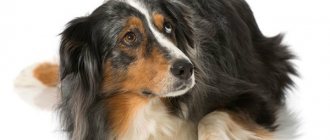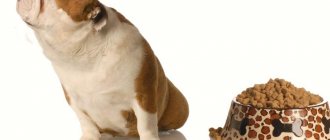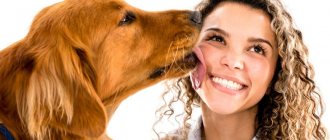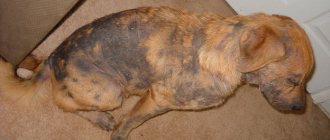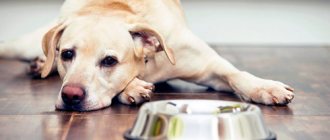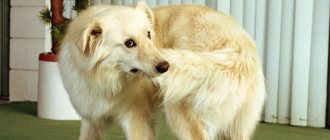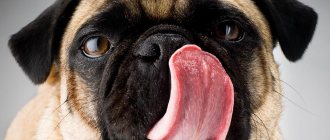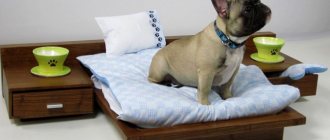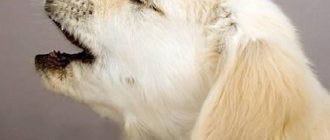You can often see a street dog tuck its paw. At this moment, you involuntarily begin to wonder what if your pet dog starts limping on his paw, be it front or back. In the case when this is a domestic dog, then almost immediately the owner begins to get nervous and panic, linking his sense of responsibility with what happened.
However, adequate behavior in such cases requires an objective assessment of the situation and timely examination at a veterinary clinic, and, if necessary, treatment. It is simply impossible to help a pet with your own efforts in some situations due to lack of experience, proper equipment and medications.
What are the reasons for a dog to tuck its paw?
It would seem that it’s just that the dog begins to tuck its paw or tail from time to time. However, this phenomenon can become an alarm bell for the manifestation of congenital pathologies such as, say, arthrosis. Therefore, let's try to understand the causes of dog lameness. First of all, it is worth excluding the most banal reasons:
- inspect the paw for the absence of any sharp objects or splinters;
- in addition, it is worth remembering whether there have been any sudden movements on the part of the pet recently in order to exclude a sprain;
- There are also more dangerous versions of events - the likelihood of the puppy developing rickets.
In most cases, hind legs become lame due to problems related to the spine, for example, a herniated disc. The secondary symptoms of this disease are:
- constant whining of the dog due to severe pain.
- unnatural arching of the back.
- Dog breeds with a fairly long body are most susceptible to this problem.
In addition, paralysis of the dog’s limbs is possible, which is perceived as a symptom of an extremely dangerous infectious disease, colloquially referred to as “distemper”, and in the scientific community as canine distemper. This disease is characterized primarily by unpredictability. It is impossible not to notice that it is extremely contagious, and treatment is quite labor-intensive. There is a real risk for the dog to remain paralyzed for life, even death.
Diagnosis of illnesses
If the dog presses its paw, or places it incorrectly, drags, and the animal’s activity has dropped: it refuses to jump, is afraid of stairs - these are symptoms that the owner urgently needs to visit a veterinarian.
The owners can first carefully examine the pads themselves; if the cause is obvious - a minor injury, scratches, cuts, a broken claw, then you can limit yourself to a thorough wound. Otherwise, contact a specialist. Even if it seems that the paw does not hurt - the dog presses it, does not use it when moving, and calmly allows it to be touched, still show the animal to a specialist. Long-term non-use of a limb leads to muscle atrophy and ligaments shorten - all this affects the prognosis and further recovery.
Sign up for a diagnosis of the causes
What is the essence of this process
If we understand the issue in more detail, we can draw the following conclusions. Often the dog begins to press his paw when the claw is broken. These situations cannot be called rare, but they are extremely painful for the dog. A broken claw needs to be removed with anesthesia. If bleeding occurs, apply a tight bandage; if possible, burn it out or resort to medications to stop the bleeding.
Immediately after the claw is removed, the rehabilitation process will begin, which can take from several months to a year for full recovery. Depending on the complexity of the wound, you can use antibiotics.
In addition, there is a possibility that a foreign object has stuck between the toes or into the pad of the paw. To relieve your dog of pain, you will need to carefully remove it using tweezers. As a rule, such objects are small pebbles, glass shards, twigs, etc. Rarely, however, excess hair can create discomfort in movement, therefore, the best option would be to get rid of it.
Dry paws are certainly accompanied by cracking of the dog’s paw pads, which affects the discomfort of the four-legged dog, causing him to tighten his paws. In this case, moisturizing creams will become a solution to the problem. You can resort to lotions, including those used for human hands. The moisturizing procedure should be followed for several days.
True, there is no need to be fanatical about solving the problem, because otherwise (excessive softness of the pad) will significantly increase the risk of injury. We can give you a little advice: after applying a layer of cream or lotion, put on a sock or special boot to prevent your pet from licking the layer.
The answer to the interesting question of why a dog tucks its back paw in some situations can be simple negligence on the part of the owner himself. The animal should not move on difficult, hard, rocky surfaces. If you cannot prevent movement in such locations, then it is advisable to wear special boots.
The problem of paw squeezing
You can often see situations where an animal begins to limp, seemingly for no objective reason. At such a moment, natural sympathy and a lightning-fast desire to help the pet solve this problem arise. However, it is worth remembering that without appropriate education and treatment experience, or special diagnostic equipment, it will not be possible to establish the reason why the dog presses its front paw. The surest way out in such a situation would be to contact a professional – a veterinarian.
Experts have been repeating to clients for many years that as soon as a four-legged animal begins to tuck in its limbs, lacks a clear line of its hind legs, eats poorly or refuses to eat at all, whines, trembles, and is unable to stay in place, an immediate visit to a veterinarian should be made.
It is enough to identify the problem on your own, and for the rest, rely on professionals
- It is highly likely that the dog is developing infectious arthritis accompanied by a tumor. You can't do without seeing a doctor.
- In the case when an animal limps after sleep, and after some time, as they say, “saunters” and returns to normal, we can judge with a high degree of confidence that this is a dislocated shoulder. Again, you won’t be able to determine the cause yourself. Most likely, an x-ray will be required here. It happens that the dog begins to limp after the injection, which indicates that the procedure was carried out incorrectly or the occurrence of painful sensations. These symptoms will pass over time, after which the pet will forget about the lameness.
- Sometimes a pet limps after a walk: it’s a good idea to check the dog’s paws. There is a risk that foreign objects have gotten into them or a claw has broken off. If you have to talk about a foreign object, then, if possible, you can try to get rid of it yourself. Removal of a broken claw is carried out by a veterinarian.
- It is not uncommon for a dog to be attacked by ticks, which then leads to infectious diseases. The course of the disease is accompanied by fever, swelling of the joints and lameness. In this case, you cannot do without the help of a specialist.
- With the periodic appearance of lameness and without the presence of all the above symptoms, it is most likely osteochondrosis.
Establishing the cause of paw curling
Canine lameness is diagnosed based on certain fundamentally different clinical signs. Often the disease manifests itself through asymmetry of movements, as well as the inability to step on the paws.
Movement disorders require treatment. True, it is impossible to cope with them without establishing the causes of the disease. Only a specialist can determine the causes of lameness based on the collected anamnestic data. In most situations, additional blood tests will be required to rule out metabolic disorders or external infections causing lameness.
Fractures. Based on the saying: “heals like a dog,” it is generally accepted that pets are quite capable of independently coping with all the consequences of falls or strong blows to the front and back line of the paws. In real life, the limb swells, which leads to lameness and illness. The four-legged animal begins to whine and show aggression.
Muscle strain occurs due to intense physical activity. The limb swells and pain occurs when supination occurs. This phenomenon can be observed in puppies in case of unsuccessful jumps.
The manifestation of myositis in a pet is quite unpleasant. Prolonged physical activity involves the accumulation of lactic acid in muscle tissue in large quantities. This, in turn, causes severe unpleasant pain. It is also interesting that weakness appears after rest, while movement reduces pain.
Lameness is the main symptom of paw disease
Damage to the limbs leads to complete or partial loss of motor function. The most striking sign of paw pathologies is lameness. It manifests itself in the fact that the dog cannot lean on its leg while moving or at rest. To choose the right treatment, it is necessary to conduct a full examination:
- taking anamnesis;
- watching the dog;
- general examination;
- examination of the pathological area;
- additional laboratory tests.
Why is the dog limping?
The cause of lameness is a pain response, and the veterinarian needs to determine the etiological factor causing the pain. Damage may be obvious or hidden. The pathological process can involve only the outer integument (wounds of the paw pads) or deep structures - diseases of the muscles, tendons, ligaments, joints and bones.
A common cause is injury. Severe mechanical damage (fall from a height, impact) leads to disruption of integrity and inflammatory processes:
- joint dislocations;
- fractures and cracks of bones;
- bruises;
- myositis;
- tendon ruptures.
Often, a minor external influence is enough to deform bones and other tissues. This is due to a decrease in bone strength and a drop in resistance. This problem is observed in old, emaciated animals. Many purebred dogs have a prevalence of congenital anomalies. Osteosarcoma and other neoplasms lead to a sharp decrease in the strength of bone tissue.
A bruise develops as a result of strong mechanical impact - a blow, a collision with a car, a fall from a height. In addition to lameness, a pronounced local reaction develops - swelling, pain. Often a bruise is accompanied by cracks and broken bones.
Lameness may indicate cracked paws in dogs. The pads on the paws crack as a result of mechanical damage, impaired keratinization, and a number of infectious pathologies. A common cause of cracked paws is poor maintenance and excess skin moisture.
Determining the cause - diagnosing limb injuries
The doctor needs to assess the general condition of the limbs. Their symmetry, length, and external integrity are noted. It should be noted what position the dog prefers to be in. The development of muscle mass and joint function are assessed.
If there is no evidence of a fracture, a gait assessment is required. Inspection is carried out from all sides to more accurately determine the damage. If the dog does not raise its paw high during movement, then the pathological process is localized in the proximal region. If the disease affects the distal areas, then the animal tries to keep its paw suspended.
Lameness on the thoracic limb is accompanied by a high elevation of the head when moving the affected paw. When the dog leans on its healthy chest leg, the head drops. When the pelvic limb is affected, in most cases it is raised upward. While moving, the dog tries to lower its head down.
A clinical examination of a sick dog necessarily includes palpation. Palpation should begin with healthy limbs in order to better identify pathology. Particular attention is paid to comparing adjacent limbs, but it is necessary to understand that many pathologies of the limbs are bilateral.
Paw inspection:
- assessment of claws - presence of fractures, abrasion, abnormal growth;
- the presence of foreign bodies in the pads and interdigital spaces, cuts, cracks on the paws of dogs;
- checking the function of the joints of each finger;
- Particular attention is paid to the condition of the metacarpophalangeal joint - fractures of the accessory bones often occur.
The inflammatory reaction is checked on the wrist - normally, the depression between the radius and carpal bones should be palpable. If you bend the limb at the carpal (tarsal) joint, you can detect a decrease in mobility, which will increase arthrosis or the inflammatory reaction.
When palpating the bones of the extremities, pain, swelling, and fracture are noted. On the distal part of the radius, tumors and signs of osteodystrophy (thinning, tissues become soft) are often found. Particular attention is paid to the elbow joint:
- lateral displacement of the radius indicates dislocation;
- incomplete fusion of the olecranon leads to hyperreflexia;
- loss of mobility and pain indicate inflammatory processes.
The examination of the pelvic limbs is identical - the integrity of the skin and bones, the presence of pain, inflammation, and swelling are determined. In the knee joint, mobility is at least 130 degrees. If you suspect that the dog has dislocated the knee joint, it is necessary to place a finger on the knee joint - the cup should move medially (in large breeds also laterally), and then return back.
X-ray allows you to visualize the location of the damage, the presence of displacement, bone fragmentation, and the size of the crack. Based on the radiograph, a conclusion is made about the need to obtain surgical access.
Medication assistance
Soft tissue diseases can usually be treated conservatively without surgery. The bruised limb is immobilized and the dog is given rest. It is better to apply a bandage and limit the mobility of the head so that the animal cannot gnaw the bandage and the damaged area - the dog gnaws its paws if they cause pain, which only intensifies the pathological process.
Cold compresses and drying alcohol lotions are applied to the injured limb. It is better to eliminate extensive accumulations of blood and lymph surgically - incisions are made and the liquid is pumped out with a syringe. Cold is applied on the first day, this helps reduce pain irritation, exudation, and accelerates blockage of blood vessels.
Starting from the second day, warming therapy begins to be used to accelerate the resorption of accumulated blood and tissue restoration. Warming compresses are applied to the affected limbs of dogs, clay and ozokerite applications are made. If, as a result of the bruise, an extensive hematoma has formed or tissue necrosis is noted, then surgical intervention is necessary. Surgeries are often performed for limb fractures.
Surgical operations on the limbs
A closed paw fracture in a dog can be eliminated using the following methods:
- repositioning of displaced debris;
- immobilization of the limb in the correct position;
- providing conditions for regeneration.
Reduction of the fragments should restore the paw bones to the correct anatomical position. The success of the operation depends on the time of reduction - the sooner help is provided, the less the fragments will disperse. Before the intervention, it is necessary to achieve maximum muscle relaxation through straightening, joint rotation and the use of special drugs.
After connecting the bone fragments, it is necessary to apply an immobilization bandage to the limb. It is better to use plaster casts without cotton lining, as this allows for better connection of bone fragments. To increase strength, it is necessary to supplement the bandage with a metal splint. Bandages are also applied if a dog’s paw is dislocated. The limb must be fixed in the joint to prevent its mobility.
Not in all cases it is possible to achieve the correct connection of bones using a conservative method. Therefore, they resort to periosteal and intraosseous osteosynthesis. This technique is also used for open fractures, when bone fragments are visible from the gaping wound. In rare cases, extraosseous osteosynthesis is used, when fragments of limb bones are secured with pins on a special frame (Ilizarov, Tkachenko apparatus).
To connect the bone fragments, it is necessary to gain access to the affected area. Then the fragments are connected using a pin laid along the brain canal (intraosseous method), or using plates with screws or wires (external method). After the formation of a callus and the connection of the fragments, a second operation is required to remove the metal connections. If a limb is broken, then osteosynthesis is the only rational way to restore the paw, but such procedures often lead to the development of osteosarcoma and other bone tumors.
What to do?
It is worth noting that in the absence of practical experience, you should not even try to solve the problem on your own when a dog presses its back paw. If we talk about the potential discovery of a splinter or glass in the paw, then it is possible to deal with it with your own efforts, taking into account preliminary disinfection of the wound. In the future, an appeal to a specialist will follow in order to rid the animal of the foreign body without consequences.
If you fall, there is always the possibility of injury or sprain. An accurate diagnosis will require x-rays. If an injury is confirmed, a full examination cannot be avoided. To exclude congenital and hereditary pathologies, information about the pedigree of the animal is required. In this case, it is worth familiarizing yourself with information about the pet from its history or talking with the puppy’s breeder.
Cause of paw tucking
It’s hard not to notice the strange behavior of the dog, pressing its paw for no apparent reason to step on it. It is important to respond to an alarm signal, especially when the dog tucks its paw and whines. It is necessary to inspect it carefully. During a walk, the dog could step on a sharp object or hit a thorn. In this case, in addition to pressing her paw, she will try to independently remove the object that is interfering with her.
by licking or trying to pull it out with your teeth. You should come to her aid: disinfect the wound and remove the stuck splinter or other foreign body with tweezers. If an object penetrates deep into the paw, you must contact a veterinarian.
A sign of behavior when a dog is tucking in his front paws is dry or cracked sole pads. This condition of the paws indicates a lack of adequate nutrition. Dry soles should be lubricated with any softening, fatty cream, and microelements and vitamin A should be added to the diet. You should put a sock on your pet's paws lubricated with the cream so that he does not lick the cream. Of no small importance is the choice of walking location where the dog can injure the soles of its paws. You should exclude her from walking in rocky areas.
A dog's restless behavior can cause a broken claw. She raises her foot because it is uncomfortable for her to step on it. It is strictly forbidden to remove the claw yourself. This operation is performed by a doctor
anesthetizing the animal. As a result, a tight bandage is applied and hemostatic drugs are administered.
The reason why a dog holds its paw up may be the cold. During a winter walk, your pet's paws may get cold, and he lifts them up one by one to warm them up. Severe hypothermia of the paws can cause the development of arthritis. The dog can hold a paw damaged by a fracture while hanging. In this case, she not only whines in pain, but may exhibit aggressive actions.
Another possibility for why your dog might have a pinched paw is a luxated kneecap or a muscle strain. When a leg is dislocated, it clicks when the knee is bent, and the dog automatically presses it to the body. In this case, you need to contact a veterinarian. In case of dislocation, a splint can be applied, and stretching the muscle brings it to its normal state - rest and massage.
Common Causes
Of course, the first time you see your ward’s leg raised, you shouldn’t rush to the veterinarian. In some situations, the owner can help on his own. Among others, there are quite banal explanations for why an animal is afraid to lean on one of its limbs:
- Splinter, cut, abrasion. Walking on less than comfortable terrain can injure and cut soft pads. It is quite common for glass shards, small pebbles, and thin slivers to get under the skin. Tweezers and disinfectant liquid will help. Carefully remove the foreign object, treat the wound, and the problem is solved.
- Dry skin on the pads. The condition of the integument depends on adequate nutrition and the location where the pet has to walk. The first signs are that the dog begins to limp on its front leg. Cracked soles of the limbs must be treated several times with regular cream: baby cream, for hands or feet. Avoid long walks on rocky surfaces and add vitamins to the diet to increase the elasticity of the skin.
- Injections in the wrong place. Often, owners themselves give the necessary injections to their charges. Failure to administer the medication causes pain and is a temporary condition. You can help by gently massaging the injection site or making a compress. And, if possible, contact a specialist for procedures.
- Cold. At low temperatures, the soles of the patient freeze, and he tries to warm them up by pressing them up one by one. With severe hypothermia, the dog's paw swells and turns red.
If the dog owner can deal with microtraumas himself, then the problem of a broken claw needs to be solved professionally. This condition is extremely painful for the dog; excruciating discomfort causes the dog to tuck its paw and whine. The damaged claw is removed under anesthesia, followed by the application of a tight bandage and hemostatic drugs.
It is strictly forbidden to subject an animal to sadistic torture and to remove the fragment yourself, without prior anesthesia. Rehabilitation will take a long time (up to a year), and you will probably need to take antibiotics. Fortunately for everyone, claw troubles are rare.
Diseases that cause lameness
A dog may press its paw and squeal when there is joint pain. This happens when she lies down or tries to get up. You should pay attention to this signal, since it is the first sign of a disease or congenital disease that appears years later:
arthrosis,- problems with the spine,
- plague disease,
- rickets, if we are talking about a puppy.
In this case, you need to contact a specialist at a veterinary center or hospital. Lameness in a dog is an alarming sign of a congenital pathology. In most cases, the dog tucks its hind legs, limping when walking, due to problems with the spine. This could be an intervertebral hernia. You should pay attention to your pet's behavior. Additional symptoms confirming spinal disease include:
- arching of the back, in which the dog tries to stretch the spine, as it were,
- constant squealing when moving due to the pain caused.
Diseases
Sometimes there are no objective reasons for a dog to be afraid to step on limbs: there are no visible damages or injuries. Such situations are much more serious and require careful observation of the behavior of your four-legged friend. The problem may be accompanied by one or more symptoms:
- There is no clear line of the hind legs.
- Limps on his hind legs.
- Lost appetite or completely refused to eat.
- Trembling, chills, whining.
See a doctor urgently! Things can be quite serious:
- Rickets is a disease of puppyhood. Causes deformation of joints, impaired positioning of limbs, and limits motor activity.
- Dislocation, spraining - often occurs in young animals after an unsuccessful jump. Or the dog curls up its front paws after sleeping, limps, and then “saunters”—almost guaranteed to have dislocated its shoulder. In any case, an x-ray will be required.
- Fracture – the injured leg, which is suspended, swells, the dog whines in pain, and can become aggressive.
- Myositis – an excess of lactic acid in the muscles due to intense physical exertion leads to unpleasant nagging pain at rest. When moving, the discomfort decreases.
- Arthritis is a painful condition when an animal literally “twists” its joints. Arthritis complicated by infection is accompanied by tumor formation.
- Infections are conditions started after a tick attack. Swollen joints in the legs ache and ache. The dog is forced to tuck its paws in and has difficulty walking.
- Plague is a terrible pathology, extremely contagious and unpredictable in forecasts. If death can be avoided, the risk of paralysis is very high
- Intervertebral hernia and osteochondrosis are a common problem in breeds with long backs. If there are problems with the spinal column, the dog tucks its hind legs, arches its back in an unnatural way, and squeals in pain.
Congenital anomalies can also cause one of the paws to constantly be suspended. For example, one leg is shorter than the others. Or a short tendon does not allow the pet to fully straighten the limb, and he is forced to limp on three legs.
If the animal does not want to rely on all four limbs, it is important to carefully study the reasons for the strange behavior. The attitude towards the problem according to the principle “it will heal like a dog” can play a cruel joke on the health of a beloved friend.

